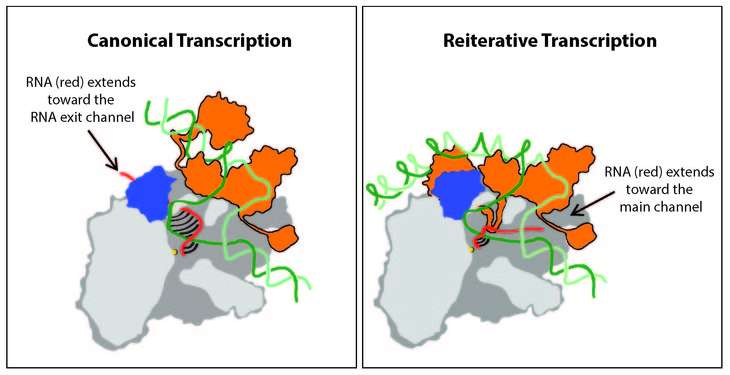Crystal structure reveals details of nonstandard RNA transcription

High-resolution crystal structure reveals a new pathway for RNA during a nontraditional form of transcription—the process by which RNA is produced from a DNA template. Caught during the act of reiterative transcription, a form of transcription in which a single base of DNA (represented by the letters A, T, C, and G) codes for several corresponding bases in the RNA (one G in DNA leads to several Gs in the RNA, for example), the new crystal structure reveals RNA exiting the polymerase enzyme through an alternative channel to enable this unconventional mode of transcription.
A paper describing the findings by a team of researchers at Penn State and the University of Alabama at Birmingham appears in the journal Proceedings of the National Academy of Sciences.
"In the classical view of X-ray crystallography, you would think that the enzyme—RNA polymerase—would be inactivated and we couldn't capture a biochemical process in action in a crystallized state," said Katsuhiko S. Murakami, professor of biochemistry and molecular biology at Penn State and an author of the paper. "But in some systems, including ours, the RNA polymerase is still alive, so we can monitor the structures while they are in the process of making RNA."
Reiterative transcription was discovered by Penn State alumnus and Nobel Laureate in chemistry Paul Berg, the Robert W. and Vivian K. Cahill Professor of Cancer Research, Emeritus, at Stanford University, in the early 1960s. Although it could appear to be a simple error in accurately transcribing the DNA sequence into RNA—reiterative transcription occurs when the strand of RNA slips relative to the strand of DNA inside the polymerase enzyme—it has function in the cell. Reiterative transcription plays a key role in controlling gene expression for many genes, but despite this important role, its mechanism has remained a black box.
"Our work expands our understanding of the flexibility of the molecular mechanisms involved in RNA transcription," said Vadim Molodtsov, a research associate at Penn State and an author of the paper. "By capturing the crystal structure of RNA polymerase during reiterative transcription we were able to identify a new pathway used by RNA to exit the enzyme. Instead of leaving through the door, it sneaks out the window."
More information: Katsuhiko S. Murakami et al, X-ray crystal structure of a reiterative transcription complex reveals an atypical RNA extension pathway, Proceedings of the National Academy of Sciences (2017). DOI: 10.1073/pnas.1702741114 , www.pnas.org/content/114/31/8211.abstract
Journal information: Proceedings of the National Academy of Sciences
Provided by Pennsylvania State University


















